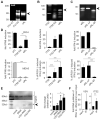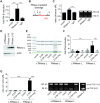A ribosomal RNA fragment with 2',3'-cyclic phosphate and GTP-binding activity acts as RIG-I ligand
- PMID: 32946572
- PMCID: PMC7544222
- DOI: 10.1093/nar/gkaa739
A ribosomal RNA fragment with 2',3'-cyclic phosphate and GTP-binding activity acts as RIG-I ligand
Abstract
The RNA helicase RIG-I plays a key role in sensing pathogen-derived RNA. Double-stranded RNA structures bearing 5'-tri- or diphosphates are commonly referred to as activating RIG-I ligands. However, endogenous RNA fragments generated during viral infection via RNase L also activate RIG-I. Of note, RNase-digested RNA fragments bear a 5'-hydroxyl group and a 2',3'-cyclic phosphate. How endogenous RNA fragments activate RIG-I despite the lack of 5'-phosphorylation has not been elucidated. Here we describe an endogenous RIG-I ligand (eRL) that is derived from the internal transcribed spacer 2 region (ITS2) of the 45S ribosomal RNA after partial RNase A digestion in vitro, RNase A protein transfection or RNase L activation. The immunostimulatory property of the eRL is dependent on 2',3'-cyclic phosphate and its sequence is characterized by a G-quadruplex containing sequence motif mediating guanosine-5'-triphosphate (GTP) binding. In summary, RNase generated self-RNA fragments with 2',3'-cyclic phosphate function as nucleotide-5'-triphosphate binding aptamers activating RIG-I.
© The Author(s) 2020. Published by Oxford University Press on behalf of Nucleic Acids Research.
Figures







Similar articles
-
The Endogenous RIG-I Ligand Is Generated in Influenza A-Virus Infected Cells.Viruses. 2021 Aug 7;13(8):1564. doi: 10.3390/v13081564. Viruses. 2021. PMID: 34452429 Free PMC article.
-
Approaching the RNA ligand for RIG-I?Immunol Rev. 2009 Jan;227(1):66-74. doi: 10.1111/j.1600-065X.2008.00724.x. Immunol Rev. 2009. PMID: 19120476 Review.
-
The C-terminal regulatory domain is the RNA 5'-triphosphate sensor of RIG-I.Mol Cell. 2008 Feb 1;29(2):169-79. doi: 10.1016/j.molcel.2007.10.032. Mol Cell. 2008. PMID: 18243112
-
LGP2 binds to PACT to regulate RIG-I- and MDA5-mediated antiviral responses.Sci Signal. 2019 Oct 1;12(601):eaar3993. doi: 10.1126/scisignal.aar3993. Sci Signal. 2019. PMID: 31575732
-
Structures of RIG-I-Like Receptors and Insights into Viral RNA Sensing.Adv Exp Med Biol. 2019;1172:157-188. doi: 10.1007/978-981-13-9367-9_8. Adv Exp Med Biol. 2019. PMID: 31628656 Review.
Cited by
-
2-5A-Mediated decay (2-5AMD): from antiviral defense to control of host RNA.Crit Rev Biochem Mol Biol. 2022 Oct-Dec;57(5-6):477-491. doi: 10.1080/10409238.2023.2181308. Epub 2023 Mar 20. Crit Rev Biochem Mol Biol. 2022. PMID: 36939319 Free PMC article. Review.
-
RTP801 interacts with the tRNA ligase complex and dysregulates its RNA ligase activity in Alzheimer's disease.Nucleic Acids Res. 2024 Oct 14;52(18):11158-11176. doi: 10.1093/nar/gkae776. Nucleic Acids Res. 2024. PMID: 39268577 Free PMC article.
-
Dissecting the role of toll-like receptor 7 in pancreatic cancer.Cancer Med. 2023 Apr;12(7):8542-8556. doi: 10.1002/cam4.5606. Epub 2023 Jan 5. Cancer Med. 2023. PMID: 36602302 Free PMC article.
-
Rcl1 suppresses tumor progression of hepatocellular carcinoma: a comprehensive analysis of bioinformatics and in vitro experiments.Cancer Cell Int. 2022 Mar 9;22(1):114. doi: 10.1186/s12935-022-02533-x. Cancer Cell Int. 2022. PMID: 35264160 Free PMC article.
-
The Endogenous RIG-I Ligand Is Generated in Influenza A-Virus Infected Cells.Viruses. 2021 Aug 7;13(8):1564. doi: 10.3390/v13081564. Viruses. 2021. PMID: 34452429 Free PMC article.
References
-
- Blasius A.L., Beutler B.. Intracellular toll-like receptors. Immunity. 2010; 32:305–315. - PubMed
-
- Yoneyama M., Kikuchi M., Natsukawa T., Shinobu N., Imaizumi T., Miyagishi M., Taira K., Akira S., Fujita T.. The RNA helicase RIG-I has an essential function in double-stranded RNA-induced innate antiviral responses. Nat. Immunol. 2004; 5:730–737. - PubMed
-
- Kato H., Takeuchi O., Sato S., Yoneyama M., Yamamoto M., Matsui K., Uematsu S., Jung A., Kawai T., Ishii K.J. et al. .. Differential roles of MDA5 and RIG-I helicases in the recognition of RNA viruses. Nature. 2006; 441:101–105. - PubMed
-
- Kato H., Takeuchi O., Mikamo-Satoh E., Hirai R., Kawai T., Matsushita K., Hiiragi A., Dermody T.S., Fujita T., Akira S.. Length-dependent recognition of double-stranded ribonucleic acids by retinoic acid-inducible gene-I and melanoma differentiation-associated gene 5. J. Exp. Med. 2008; 205:1601–1610. - PMC - PubMed
Publication types
MeSH terms
Substances
LinkOut - more resources
Full Text Sources
Molecular Biology Databases

